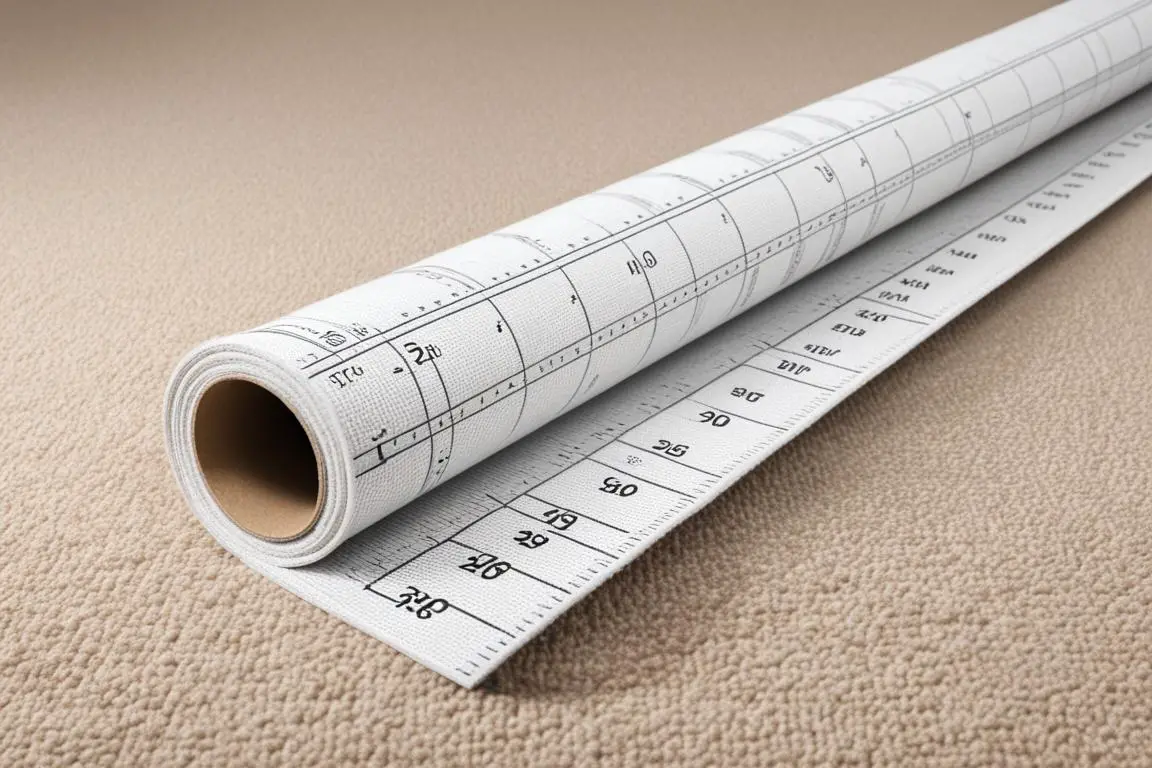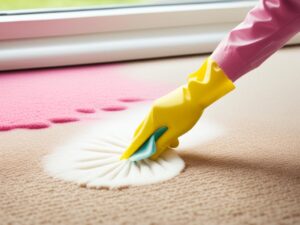When preparing for a carpeting installation, it is essential to consider the size of your room and the specific carpeting product you intend to purchase. The roll width of the carpeting is a crucial factor in determining how to measure your space accurately.
Carpet rolls are typically available in widths of 12 feet, but other widths, such as 15 feet or half-measures like 13’6″, may also be available. It’s important to adjust your room measurements accordingly based on the specific carpeting product you plan to buy.
Key Takeaways:
- The standard width of a carpet roll is typically 12 feet.
- Other widths, such as 15 feet or 13’6″, may also be available.
- Adjust your room measurements based on the specific carpeting product you plan to buy.
- Consider the roll width when determining how to measure your space accurately.
- Consult with your carpeting vendor for guidance on measuring and purchasing the right size carpet.
Factors to Consider in Carpet Measurement
Accurate carpet measurement is crucial for a successful installation. Along with the roll width, there are several other factors that need to be considered to ensure precise measurements. These factors include:
- Pattern Matching: When measuring your space for carpet installation, it’s important to consider pattern matching. This is particularly crucial when creating a continuous flow between rooms without interruptions. Matching patterns seamlessly enhances the overall aesthetic appeal of your carpeting.
- Carpeting Seam Positioning: Another important factor is the positioning of carpeting seams. During the measurement process, it’s necessary to plan and determine where the seams will be placed. Proper seam positioning helps achieve a neat and visually pleasing installation.
- Carpet Measuring Services: To ensure accurate measurements, it’s highly recommended to take advantage of professional carpet measuring services offered by reputable vendors. These services utilize advanced techniques and tools to accurately measure your space, taking into account all the necessary factors and considerations.
By considering these factors as part of the carpet measurement process, you can ensure precise measurements that result in a visually appealing and properly installed carpet.
Quote:
“Accurate measurement is the foundation of a successful carpet installation. Taking into account factors like pattern matching and carpeting seam positioning ensures a visually pleasing outcome.”
Carpet Measurement Factors Table
| Factors to Consider | Description |
|---|---|
| Pattern Matching | Matching patterns seamlessly creates a continuous flow between rooms. |
| Carpeting Seam Positioning | Proper placement of seams ensures a neat and visually pleasing installation. |
| Carpet Measuring Services | Professional services that utilize advanced techniques for accurate measurements. |
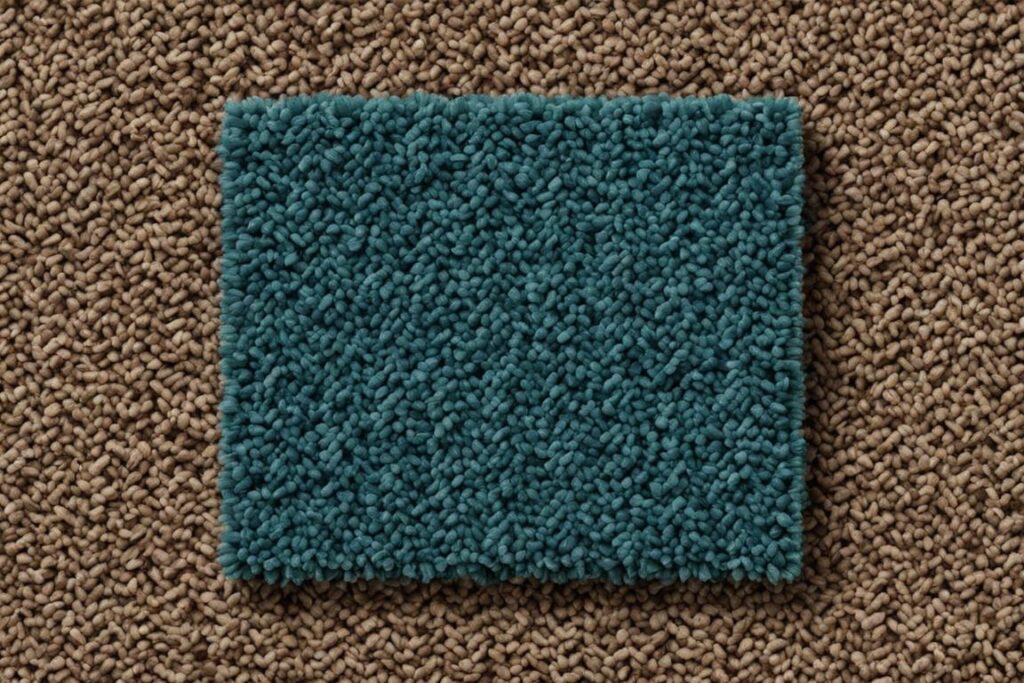
In text must include SEO relevant keywords – carpet measurement, accurate carpet measurement, pattern matching, carpeting seam positioning, carpet measuring services.
How to Measure a Carpet Roll
To ensure accurate measurements for your carpet installation, it is essential to know how to measure a carpet roll properly. By determining the carpet roll’s diameter, thickness, and other key measurements, you can calculate the final square feet of the carpet for your room.
Measuring the Diameter and Thickness
Start by measuring the diameter of the entire carpet roll and the hole in the center. Use a measuring tape or ruler to determine these dimensions in inches. Additionally, measure the thickness of the carpet roll in inches.
Remember: Accurate measurements are crucial to ensure precise carpet installation.
Calculating the Carpet Roll Area
Once you have the diameter and thickness measurements, you can calculate the carpet roll’s total area. Use the following formula:
Carpet Roll Area = π * r²
where π (pi) is approximately 3.14 and r represents the radius of the carpet roll (half of the diameter). This formula will give you the area of both the entire roll and the hole.
Next, subtract the area of the hole from the area of the entire carpet roll to obtain the adjusted area. This adjusted area will be used to calculate the linear length of the carpet.
Calculating the Linear Length and Final Square Feet Measurement
To calculate the linear length of the carpet, divide the adjusted area by the thickness measurement. Convert the linear length from inches to feet.
For the width of the carpet on the outside of the roll, measure in feet. This measurement, along with the linear length, will allow you to calculate the final square feet measurement. Simply multiply the linear length by the width to obtain the square feet of the carpet for your room.
Tip: Working with accurate measurements will help you choose the right amount of carpet and ensure a smooth installation process.
To summarize the process:
- Measure the diameter and thickness of the carpet roll in inches.
- Calculate the carpet roll area using the formula π * r².
- Subtract the area of the hole from the area of the entire roll to get the adjusted area.
- Divide the adjusted area by the thickness measurement and convert the linear length from inches to feet.
- Measure the width of the carpet on the outside of the roll in feet.
- Multiply the linear length by the width to obtain the final square feet measurement.
By following these steps, you can accurately measure a carpet roll and determine the appropriate amount of carpet for your space.
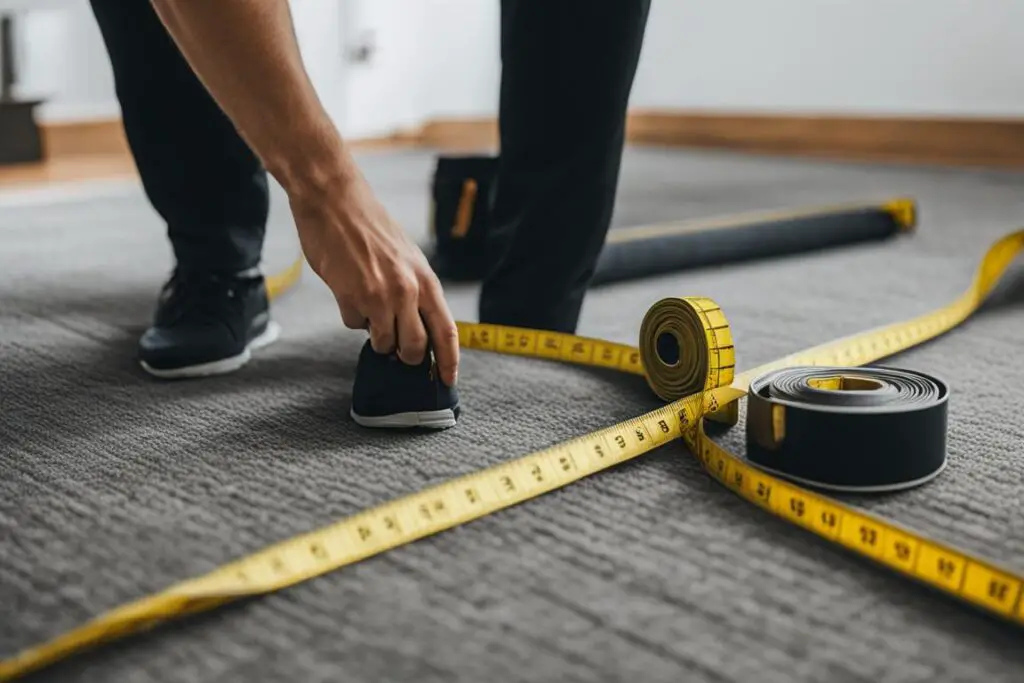
Carpet Measurements and Comparison
When comparing different flooring options, it’s important to consider the carpet measurements to ensure a true comparison. Carpet is typically manufactured in rolls with widths of 3.66 or 4 meters. When buying carpet, it is sold by linear or broadloom meters, which are equivalent to one meter of the carpet roll width.
Converting carpet measurements to square meter prices allows for a fair comparison with other flooring solutions that are sold in different box sizes or roll lengths. By converting the measurements, you can accurately compare the cost per square meter across various flooring options and make an informed decision.
Comparison Table: Flooring Measurements and Prices
| Flooring Type | Measurement Unit | Price per Square Meter |
|---|---|---|
| Carpet | Linear/Broadloom Meter | $X.XX |
| Timber | Square Meter | $X.XX |
| Laminate | Square Meter | $X.XX |
As shown in the comparison table above, carpet measurements are converted to square meter prices for accurate pricing comparison. This enables you to assess the cost-effectiveness of each flooring option and find the best value for your budget.
In addition to cost, it’s also crucial to consider other factors such as durability, maintenance requirements, and aesthetic appeal when choosing flooring for your space. By carefully considering all these factors, you can make an informed decision and select the flooring option that best meets your needs.
Factors to Consider When Choosing Flooring
When it comes to choosing flooring for your space, several factors should be taken into consideration. Each factor plays a crucial role in determining the type of flooring that will best suit your needs. By carefully considering these factors, you can make an informed decision that ensures both functionality and aesthetics for your space.
- Lifespan: Determine the desired lifespan of your flooring. Are you looking for a short-term solution or a long-term investment? Consider the durability and maintenance requirements of different flooring options to ensure they meet your lifespan expectations.
- Lifestyle Considerations: Take into account your lifestyle and the activities that will take place on the flooring. For example, if you have a busy household with kids and pets, you may want to opt for a flooring option that is highly durable and easy to clean. Conversely, if you have a quieter adult home, you may have more flexibility in terms of flooring choices.
- Budget: Consider your budget when selecting flooring options. While it may be tempting to choose the cheapest option available, it’s important to evaluate the long-term cost-effectiveness. Cheaper flooring options may require more frequent replacements or repairs, ultimately costing you more in the long run.
- Underlay: Don’t overlook the importance of investing in good quality underlay. Underlay provides added cushioning, noise reduction, and insulation, enhancing the overall comfort and performance of your flooring.
- Expert Advice: Seek guidance from flooring professionals who can provide expert advice tailored to your specific needs. They can help you navigate through the wide range of flooring options available and select the most suitable one based on your budget, lifestyle, and design preferences.
By considering these factors and gathering expert advice, you can confidently choose the right flooring option that aligns with your requirements, enhances the aesthetics of your space, and provides long-term satisfaction.
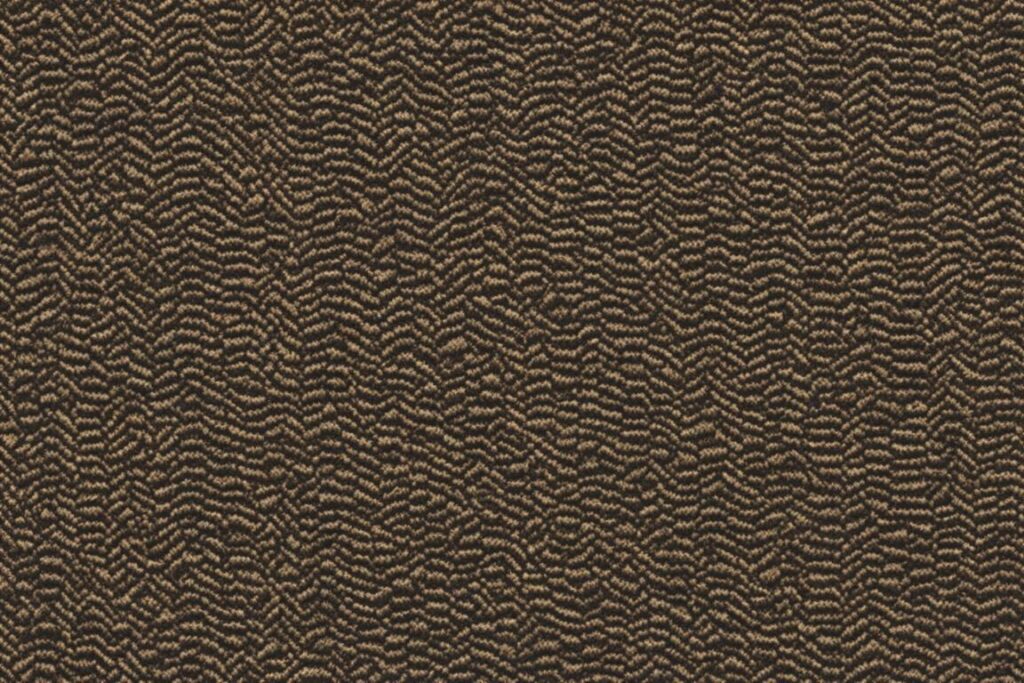
Flooring Measurements Explained
Different types of flooring, such as carpet, timber, laminate, tiles, and vinyl, are available in various box sizes, roll widths, and roll lengths. To accurately compare prices, the square meter price is often used for all flooring products. Let’s take a closer look at how carpet measurements are handled:
- Carpet: Carpet is manufactured in rolls with standard widths of 3.66 or 4 meters.
- Linear/Broadloom Meter: Carpet can only be purchased by linear or broadloom meters. A linear meter represents 1 meter of the carpet roll width. This means that if you need a carpet with a width of 4 meters, you will purchase 4 linear meters of carpet.
- Square Meter Price Comparison: To make a fair comparison between different flooring options, including carpet, converting the measurements to square meter prices is crucial. This allows for an accurate assessment of the cost per square meter, regardless of the flooring type. You can determine the square meter price by dividing the total price by the total area in square meters.
By understanding the various flooring measurements and using the square meter price, you can make informed decisions when comparing different flooring solutions.
| Flooring Type | Roll Width | Measurement Unit |
|---|---|---|
| Carpet | 3.66 or 4 meters (standard) | Linear or Broadloom Meter |
| Timber, Laminate | Varies | Square Meter |
| Tiles, Vinyl | Varies | Box or Square Meter |
When comparing flooring options, understanding the measurements and conversion to square meter prices will help you make an informed decision that aligns with your budget and space requirements.
Conclusion
Understanding the standard carpet roll width is crucial for selecting and measuring carpet for your space. The roll width not only affects how you measure your room but also ensures accurate installation. When measuring for carpeting, consider factors such as pattern matching and carpeting seam positioning to achieve a seamless look. Seeking expert advice from trusted flooring professionals and utilizing carpet measuring services provided by reliable vendors can help you obtain precise measurements.
By carefully considering these factors and taking advantage of specialized services, you can make informed choices that meet your specific flooring needs. Remember that accurate measurement is key to a successful carpet installation, and the standard carpet roll width serves as a foundation for the entire process. So, whether you’re renovating your home or installing new carpeting, understanding and implementing the correct measurements will help you achieve the desired aesthetic and functionality for your space.
In conclusion, the standard carpet roll width is an essential aspect of the carpeting installation process. It influences how you measure your room, consider pattern matching, and position carpeting seams. By working with knowledgeable professionals and utilizing specialized measuring services, you can ensure accurate measurements and make informed decisions for your flooring needs. With proper measurement techniques and a clear understanding of the standard carpet roll width, you can achieve a beautiful and well-fitted carpet that enhances the overall design and comfort of your space.
FAQ
How wide is a carpet roll?
Carpet rolls are typically available in widths of 12 feet, but other widths such as 15 feet or half-measures like 13’6″ may also be available.
What factors should be considered in carpet measurement?
Factors like pattern matching and carpeting seam positioning should be taken into account during the measurement process. It’s recommended to work closely with your carpeting vendor and take advantage of their carpet measuring services to ensure accurate measurements.
How do you measure a carpet roll?
To measure a carpet roll, you will need to determine the diameter and thickness of the roll. The linear length of the carpet can be found by dividing the adjusted area by the thickness measurement and then converting the linear length from inches to feet. The width of the carpet on the outside of the roll should be measured in feet, and the final square feet measurement can be obtained by multiplying the linear feet by the width measurement.
How are carpet measurements compared to other flooring options?
Carpet is typically produced in rolls with widths of 3.66 or 4 meters. It is sold by linear or broadloom meters, which are equivalent to one meter of the carpet roll width. To make a true comparison between different flooring options, carpet measurements are often converted to square meter prices.
What factors should be considered when choosing flooring?
Factors to consider when choosing flooring include the lifespan needed, lifestyle considerations, budget, and the practicality of the flooring options. Seeking expert advice from flooring professionals is also recommended.
How are flooring measurements expressed?
Carpet, as well as other types of flooring, is supplied in various box sizes, roll widths, and roll lengths. Carpet measurements are often expressed using linear or broadloom meters, which equate to one meter of the carpet roll width. To compare prices accurately, measurements are converted to square meter prices.
